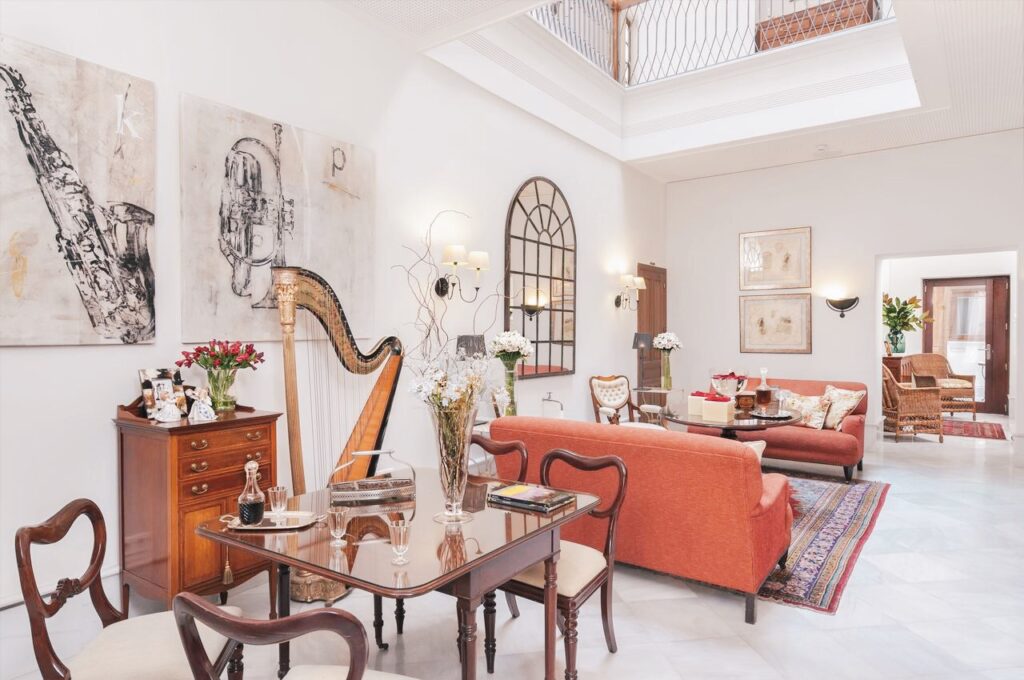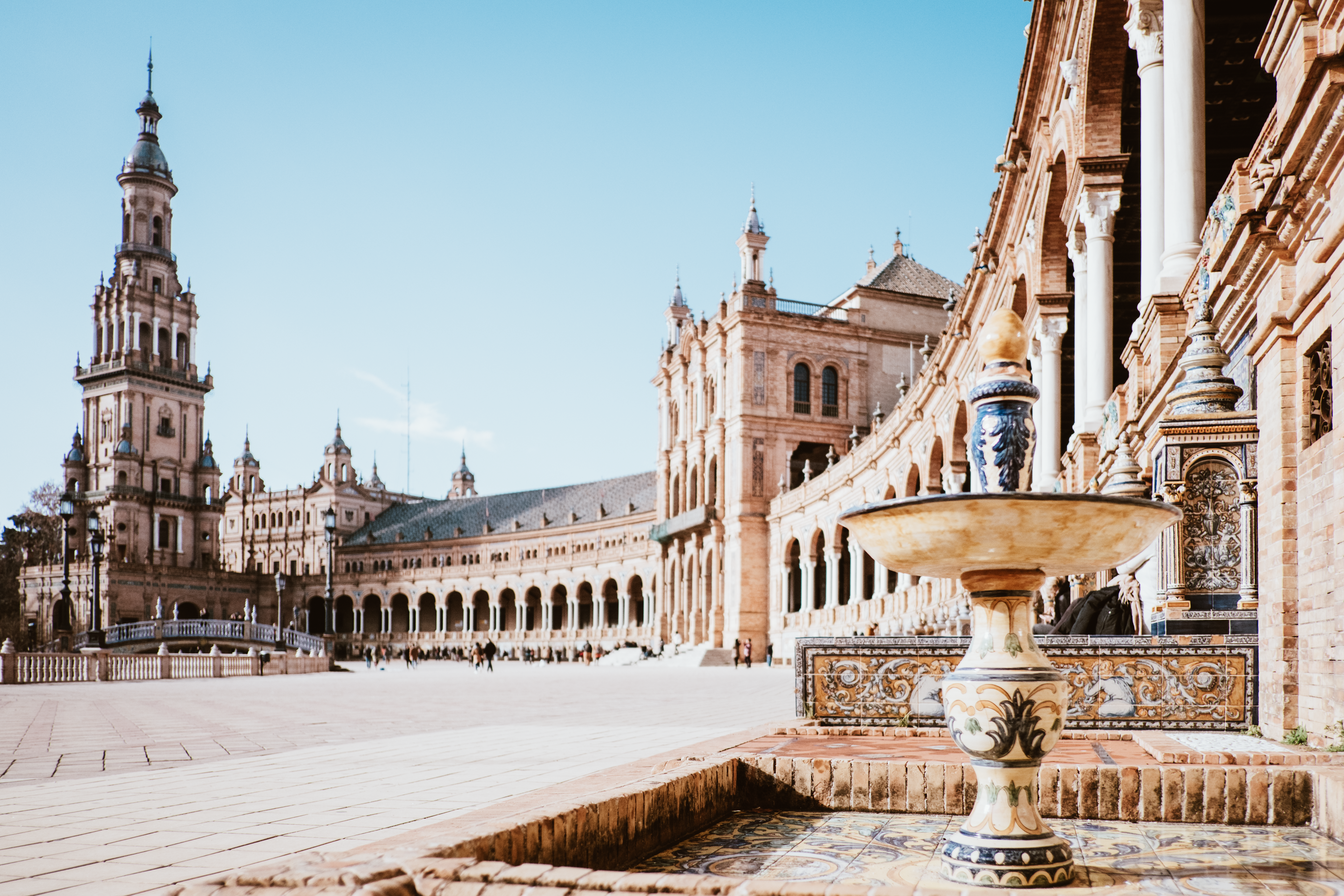Seville has several claims to fame: not only is the city widely considered to be the birthplace of tapas and the spiritual home of flamenco, but it’s also home to the world’s largest Gothic cathedral and the largest preserved historic center in Europe.
This a city certainly steeped in history, with magnificent architectural landmarks that reveal the Roman, Muslim, Christian and Jewish influences that have shaped Andalusia’s culture over thousands of years. Seville’s proud inhabitants retain a fiercely traditional way of life, and their warm hospitality and laidback lifestyle ensure the city remains one of the most—if not the most—alluring destinations in Spain and the perfect city break for you.
Eat
There are plenty of tourist traps in Seville’s historic center, so take care when it comes to choosing where to eat. As you might expect, tapas restaurants rule the day here and can be found on practically every street corner. Tapas are traditionally eaten standing next to the bar, and the more packed and boisterous the venue, the better the food is likely to be. Flag down a waiter to order, and pay at the end according to how many dishes you’ve consumed.
Stalwart tapas dishes in Seville include jamón ibérico, mouth-watering slivers of cured local ham, salmorejo, a creamy cold tomato soup, and solomillo al whisky, pork loin marinated in whisky, garlic and lemon. The city’s Moorish influences come to play in dishes such as espinacas con garbanzos, which consists of spinach, chickpeas, cumin and garlic. Boquerones are tiny anchovies either marinated or fried. Pair tapas with draft beer—Cruzcampo is a local favorite—a glass of chilled sherry, or a sweet and aromatic vermouth.
There’s one tapas restaurant you can’t miss. El Rinconcillo is the oldest restaurant in Seville—it opened in 1670—and maintains a delightfully old-school ambience and consistently good food, despite its iconic status—many believe tapas originated from here. For something a little more contemporary, try the “gastrotapas” at La Azotea, which has four branches across the historic center.
Seville also has a number of food markets, ideal for picking up ingredients for a picnic along the Guadalquivir river. There’s a lively market in Triana, the old gypsy quarter across the river, and Mercado Lonja del Barranco includes street food-style stalls as well as produce. Another good bet is Mercado de la Encarnación, set under La Metropol Parasol, a bizarre mushroom-shaped monument that has become one of the city’s iconic landmarks since it was completed in 2011. While you’re here, pop down to the basement Antiquarium Museum, which displays the archaeological remains found when Las Setas, as it’s commonly called, was constructed.

For a modern twist on tapas classics, visit one of the La Azotea eateries around the city. Credit: La Azotea 
An oldy but a goody, El Rinconcillo is considered the home of tapas. Credit: El Rinconcillo
Play
Seville has a large and well-preserved historic center, and Santa Cruz is the most picturesque part. It’s easy to get lost among the winding medieval alleyways of this charming barrio, which are lined with Baroque palaces, ancient churches and whitewashed houses festooned with geraniums, and open onto quaint squares with orange trees and pavement cafes.

Santa Cruz is where you’ll find the city’s three most important monuments. The dazzling Real Alcázar is one of the most notable examples of Andalusia’s Mudéjar architecture, which combines Moorish and Christian influences, and features ornate arches, exquisite tilework and enchanting gardens that you may recognise as the setting for The Water Gardens of Dorne in “Game of Thrones.”
Adjoining the Alcázar is Seville Cathedral, the largest Gothic cathedral in the world and built on the site of a great mosque in the 15th century. What was the minaret now forms The Giralda bell tower, which you can climb for incredible views of the city’s rooftops. Make sure you buy tickets in advance for both the Alcázar and the cathedral, as the lines to get in can be very long, especially in summer.
For a sense of Seville’s living history and for a more exciting thing to do, catch a flamenco performance. This evocative artform combines poetry, singing and guitar with dance and rhythmic hand-clapping and originated with the Roma, who migrated to southern Spain from Rajasthan, India, between the 9th and 14th centuries. One way to see a professional performance is through a tablao, a choreographed, theater-style show often accompanied by dinner. Palacio Andaluz, which moved to a new location on the Isla de la Cartuja at the end of 2019, hosts two nightly shows.

There’s nothing fake about the Real Alcázar. Credit: Unsplash 
No horsing around, Seville is serious about Flamenco. Credit: Nick Karvounis/Unsplash
A more intimate experience can be found at Casa de la Memoria, a cultural center set in a 15th-century palace that hosts nightly performances on a central patio. Even more authentic yet is catching a spontaneous show in a flamenco bar. You may be lucky to stumble upon a late-night performance in one of the bars in Triana, the old gypsy quarter, with Casa Anselma (Calle Pagés del Corro 49) a reliable bet—the owner is a celebrated flamenco artist herself, and passionate performances take place most nights. Entrance is free as long as you buy drinks, but be warned that things only start getting going after midnight.
If you have time for only one museum, make it the Museum of Fine Arts, which features works from the medieval period to the present and is regarded as the country’s second most important art collection after The Prado in Madrid. The building it is housed in—a former convent dating from the 16th-century—is almost as exquisite as the artworks housed within.

Stay cool with a visit to the Alcázar’s Maria de Padilla Bathrooms. Credit: David Groves/Unsplash 
One of the city’s biggest attractions, Seville’s Cathedral is an impressive structure. Credit: Unsplash
Stay
Hotel Amadeus & La Musica
Stay in Santa Cruz and you’ll find everything on your doorstep, including lively bars and plenty of cafes and restaurants. Hotel Amadeus & La Musica is a music-themed hotel set in two 18th-century houses, with rooms named after famous composers—one even has its own piano. Head up to the bar on the roof terrace for afternoon snacks or cocktails, or make use of the hot tub. Breakfast is served until 1 p.m., which is rather considerate if you’ve been up late the night before.
The adjoining neighbourhoods of Alameda and La Macarena are a little further out—they’re in the northern part of the historic centre, around half an hour on foot from the cathedral—but have transformed from rough-around-the-edges to hipster haven over the past decade.

A relaxing night at the Hotel Amadeus & La Musica sounds like music to our ears. Credit: Hotel Amadeus & La Musica/Booking.com 
Not to harp on about it but staying at Hotel Amadeus & La Musica is a delight. Credit: Hotel Amadeus & La Musica/Booking.com
Hotel Alcoba del Rey
Set next to the Basilica de la Macarena, a focal point of the city’s legendary Santa Semana celebrations, Hotel Alcoba del Rey was once a Mudéjar palace and retains a Moorish theme, with horseshoe arches, embellished mirrors, intricately patterned tiles and colourful bedrooms with canopied four-poster beds. There’s a rooftop terrace with a hot tub here too, and the adjoining restaurant serves delicious tapas at reasonable prices.

Embracing Seville’s Moorish history, Alcoba del Rey is a inviting stay. Credit: Hotel Alcoba del Rey/Booking.com 
Enjoy a night on the tiles at the hotel’s bar. Credit: Hotel Alcoba del Rey/Booking.com
